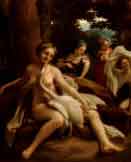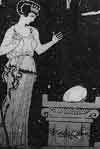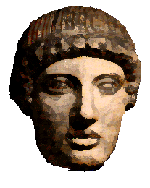Helen
Hatched, not born
While authorities all agree Helen was hatched from an egg, there the consensus ends. It's very much a case of "which came first, Helen or the egg". There are many versions of the "original story". The swan's egg version gets a first literary mention in Euripides' Helen - where Helen humorously suggests that she's always been thought of as a freak since her embarrassingly abnormal birth! But vase painters had for many years appreciated the artistic possibilities (as did Correggio and many others subsequently).

"Sparta (you've heard of it?)
Was my home, and my father was Tyndareus.
There's a rather silly story that Zeus
Came to Leda, my mother, in a flap - literally!
Disguised as a bird - a swan - with an eagle in pursuit.
An intriguing excuse to get into bed with her!"
Euripides' HELEN tr Andrew Wilson - complete
play is online on this site.
Leda & the Swan
 Version
1: Zeus in his swan guise had sex with Leda - on the same night as did
her husband Tyndareus, king of Sparta. She produced an egg - which held
Helen and Polydeuces (children of Zeus) and a child Castor (son of Tyndareus).
Other versions have two eggs - Zeus' as before, but also Tyndareus'
which contained Castor and in some accounts Clytemnestra. Helen is always
called the daughter of Zeus - unless someone is trying to insult her.
Her bothers were known as the Dioskouroi or Dioscuri - Zeus' lads. Homer
in Odyssey Book 11 outlines the problems of having an immortal sibling
- Polydeuces (Pollux in Latin) shares his immortality with his brother
on alternate days, but they can never meet. Clytemnestra is always "daughter
of Tyndareus", and her eggy origin is seldom referred to.
Version
1: Zeus in his swan guise had sex with Leda - on the same night as did
her husband Tyndareus, king of Sparta. She produced an egg - which held
Helen and Polydeuces (children of Zeus) and a child Castor (son of Tyndareus).
Other versions have two eggs - Zeus' as before, but also Tyndareus'
which contained Castor and in some accounts Clytemnestra. Helen is always
called the daughter of Zeus - unless someone is trying to insult her.
Her bothers were known as the Dioskouroi or Dioscuri - Zeus' lads. Homer
in Odyssey Book 11 outlines the problems of having an immortal sibling
- Polydeuces (Pollux in Latin) shares his immortality with his brother
on alternate days, but they can never meet. Clytemnestra is always "daughter
of Tyndareus", and her eggy origin is seldom referred to.
Version 2: Zeus fell in love with the goddess Nemesis. To escape she tried every possible animal disguise - but he was ahead of her with a swifter or more aggressive beast every time. At last she decided to fly away, and became a goose - but he became a swan, who finally met his Nemesis at Rhamnous in NW Attica (where you can visit the remains of the great temple of Nemesis - and where her cult statue, smashed to smithereens by ancient vandals, is being painstakingly restored). Nemesis accepted the inevitable and in due course produced an egg (hyacinth-coloured apparently, ie blue), which she laid in a marsh near Sparta. Leda found it and brought it home and kept it safe until it hatched. Or - according to others - the egg was craftily secreted between Leda's thighs by Hermes. Or it dropped from the moon. Or a shepherd found it in the woods and brought it to the queen, who kept it in a box until Helen hatched out. Leda then brought her up as her own daughter. This the version preferred by Greek artists - athough the Attic painter seems to show Leda mightily surprised to find the egg lying on the altar of Zeus!
More to come...

